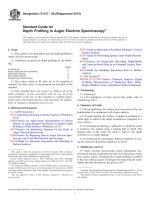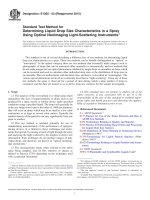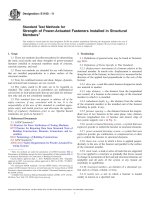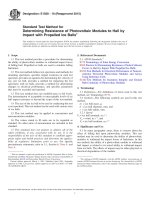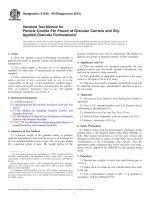Astm e 2340 e 2340m 11 (2015)
Bạn đang xem bản rút gọn của tài liệu. Xem và tải ngay bản đầy đủ của tài liệu tại đây (106.31 KB, 6 trang )
Designation: E2340/E2340M − 11 (Reapproved 2015)
Standard Test Method for
Measuring the Skid Resistance of Pavements and Other
Trafficked Surfaces Using a Continuous Reading, Fixed-Slip
Technique1
This standard is issued under the fixed designation E2340/E2340M; the number immediately following the designation indicates the year
of original adoption or, in the case of revision, the year of last revision. A number in parentheses indicates the year of last reapproval.
A superscript epsilon (´) indicates an editorial change since the last revision or reapproval.
1.10 The values stated in either SI units or inch-pound units
are to be regarded separately as standard. The values stated in
each system may not be exact equivalents; therefore, each
system shall be used independently of the other. Combining
values from the two systems may result in non-conformance
with the standard.
1.11 This standard may involve hazardous materials,
operations, and equipment. This standard does not purport to
address all of the safety concerns, if any, associated with its
use. It is the responsibility of the user of this standard to
establish appropriate safety and health practices and determine the applicability of regulatory limitations prior to use.
Safety precautionary information is contained in Section 7.
1. Scope
1.1 This test method covers the measurement of the skid
resistance of a pavement or other trafficked surface using the
continuous reading, fixed-slip technique.
1.2 This test method covers braked wheel measurements
obtained with less than 100 % slip. It does not cover side force
measurements.
1.3 This test method provides a record of the skid resistance
along the whole length of one track of the test surface and
enables averages to be obtained for specified test segments.
1.4 This test method is used to measure skid resistance on a
wide variety of surfaces in a wide variety of circumstances.
Consequently, there are many different designs of continuous
reading, fixed-slip measuring equipment (CFME) and as many
different test procedures governing their use.
2. Referenced Documents
2.1 ASTM Standards:2
E178 Practice for Dealing With Outlying Observations
E501 Specification for Rib Tire for Pavement SkidResistance Tests
E524 Specification for Smooth Tire for Pavement SkidResistance Tests
E867 Terminology Relating to Vehicle-Pavement Systems
E1551 Specification for Special Purpose, Smooth–Tread
Tire, Operated on Fixed Braking Slip Continuous Friction
Measuring Equipment
E1844 Specification for A Size 10 × 4–5 Smooth-Tread Friction Test Tire
F408 Test Method for Tires for Wet Traction in StraightAhead Braking, Using a Towed Trailer
F457 Test Method for Speed and Distance Calibration of
Fifth Wheel Equipped With Either Analog or Digital
Instrumentation
1.5 This test method does not attempt to detail these
different equipments and procedures but does set out the
essential common principles.
1.6 CFMEs function by creating and measuring a frictional
force between a test tire operating at a selected slip and the test
surface. Different types of CFME do not necessarily create the
same frictional force between their particular test tire and a
common test surface and do not necessarily use the same
method to measure this frictional force.
1.7 CFME measurements are obtained at a selected steady
test speed. This speed may vary according to the application.
1.8 The test surface may be contaminated or clean and dry.
If it is clean and dry, a measured amount of water is normally
deposited on the surface just in front of the test wheel.
1.9 The measuring apparatus may be built into a vehicle,
built into a trailer that is towed by a vehicle, or built into a
device that is manually pushed.
3. Terminology
3.1 For definitions of terms used in this test method, refer to
Terminology E867.
1
This test method is under the jurisdiction of ASTM Committee E17 on Vehicle
- Pavement Systems and is the direct responsibility of Subcommittee E17.21 on
Field Methods for Measuring Tire Pavement Friction.
Current edition approved Sept. 1, 2015. Published December 2015. Originally
approved in 2006. Last previous edition approved in 2011 as E2340/E2340M – 11ɛ1.
DOI: 10.1520/E2340_E2340-11R15.
2
For referenced ASTM standards, visit the ASTM website, www.astm.org, or
contact ASTM Customer Service at For Annual Book of ASTM
Standards volume information, refer to the standard’s Document Summary page on
the ASTM website.
Copyright © ASTM International, 100 Barr Harbor Drive, PO Box C700, West Conshohocken, PA 19428-2959. United States
1
E2340/E2340M − 11 (2015)
3.2 Definitions:
3.2.1 braking force, n—dynamic instantaneous frictional
force acting on the test wheel.
3.2.2 braking force coeffıcient (BFC), n—appropriately filtered mean of a number of instantaneous friction readings over
a defined distance.
3.2.3 braking slip friction, n—tangential force generated
between the test tire and the test surface.
3.2.4 braking slip ratio, n—ratio of relative braking slip
circumferential speed to identical unbraked wheel circumferential speed, usually defined as a percent.
3.2.4.1 Discussion—An equivalent definition is the ratio of
the relative braking slip velocity to the horizontal velocity of
the wheel axle.
3.2.5 continuous reading, fixed slip-measuring equipment
(CFME), n—apparatus that can be moved over the test surface
at the chosen test speed and includes a test wheel, a system for
braking the test wheel, and instrumentation for measuring the
resulting frictional force between the test tire and test surface.
3.2.6 fixed slip, n—braking system that forces the test wheel
to roll at a constant slip or fixed reduction of its free rolling
speed.
3.2.7 frictional force, n—resistance generated when one
surface moves relative to another with which it is in contact.
3.2.8 instantaneous friction reading, n—braking force divided by load or equivalently divided by torque on the test
wheel (generated by braking force) divided by load times tire
radius (moment arm).
3.2.9 load force, n—dynamic instantaneous vertical force
acting on the test wheel.
3.2.10 nominal water film thickness, n—thickness of the
film that the water application system is designed to create
ahead of the test tire on an entirely smooth test surface.
3.2.11 rate of water flow, n—rate at which water is applied
to the test surface in front of the test tire.
3.2.12 reporting length, n—defined length over which the
BFC is calculated.
3.2.13 standard nominal water film thickness, n—nominal
water film thickness associated with CFME measurements of a
particular type of test application to facilitate comparisons
between the results of different tests.
3.2.14 standard test speed, n—steady test speed associated
with CFME measurements of a particular type of test application to facilitate comparisons between the results of different
tests.
3.2.15 test speed, n—steady test speed associated with
CFME measurements.
3.2.16 water application system, n—system for depositing a
given amount of water in front of the test tire so that it passes
between the tire contact area and the test surface.
carried out once a year; the procedure records both as found
values and adjusted values.
3.3.2 field calibration, n—primary force calibration or the
equivalent carried out before each test or series of tests by a
trained operator using calibration equipment supplied by the
manufacturer; this equipment may be built into the CFME.
3.3.3 friction map, n—presentation of friction readings obtained down the length of a test surface (typically an airport
runway) over a series of selected paths down the surface.
3.3.4 operational friction testing, n—measurement of the
friction of a surface in response to an operational need and in
whatever conditions exist at the time of the test, which may
include contamination by ice, snow, slush, or water; these tests
do not include the application of water.
3.3.5 routine friction testing, n—measurement of the friction
of a surface under standardized test conditions that normally
includes a standard test speed and a rate of water flow which
gives a standard nominal water film thickness.
3.3.6 test tire, n—standard tire for pavement friction testing;
test tires for routine friction testing shall have a smooth tread.
4. Summary of Test Method
4.1 The test system is moved over the test surface at the
chosen test speed with the test wheel, fitted with a test tire, and
forced to roll at a particular braking slip ratio.
4.2 If routine friction testing is taking place, the rate of
water flow is adjusted to the test speed so that the chosen
nominal water film is achieved.
4.3 The braking force or torque is measured (see Terminology E867) and the load is measured, calculated, or assumed to
be the same as the dead weight load.
4.4 The instantaneous friction reading is calculated.
4.5 Either the instantaneous friction reading is recorded or
the BFC for each friction length is calculated and recorded.
4.6 Test speed (see Test Method F457), rate of water flow,
and other essential supporting data are recorded.
5. Significance and Use
5.1 CFMEs are used to measure skid resistance on runways,
roads, and various other trafficked surfaces. These tests may
comprise operational testing, performed to obtain an immediate assessment of skid resistance in current conditions or
routine testing in standardized conditions which include the
application of a precise amount of water in front of the test tire.
5.2 Standard test speeds and nominal water film thicknesses
are according to national or international agency standards, the
type of CFME, and the test application. Some examples of
typical applications are given in Appendix X1.
6. Apparatus
6.1 Basic Measurements:
6.1.1 The test apparatus shall be equipped with a force
transducer to provide a direct measurement of the braking force
or a torque transducer to measure the torque on the test wheel
generated by this force or both.
3.3 Definitions of Terms Specific to This Standard:
3.3.1 certifying calibration, n—verification of test
equipment, calibration equipment (separate or inbuilt), calibration procedures, and equipment operation recommended to be
2
E2340/E2340M − 11 (2015)
6.4.1 The test apparatus shall be such that the chosen fixed
braking slip can be maintained within 63 % of full scale
throughout the length of the test surface at the chosen test
speed (for example, if the chosen fixed braking slip is 15 %, a
braking slip between 12 and 18 % shall be maintained).
6.1.2 The design of the test apparatus shall ensure that
unless the average load force acting on the test wheel remains
within 1 % of the static wheel load over the reporting length,
the apparatus shall be equipped with a force transducer to
measure the load force.
6.1.3 The test apparatus shall include a mechanism for
measuring test speed and distance traveled.
6.1.4 Unless the test apparatus is to be used solely for
operational testing, it shall include a mechanism for measuring
rate of water flow.
6.5 Test Speed—With the test tire operating at the chosen
fixed braking slip, the test apparatus shall be capable of
maintaining the chosen test speed within 63 % for the duration
of the survey.
6.6 Test Tire—The test tire shall conform to the applicable
ASTM, ISO, or BSI specification or equivalent. Applicable
ASTM standards include Specifications E501, E524, E1551
and E1844.
6.2 Tolerance for Adverse Conditions:
6.2.1 The exposed portions of the system shall tolerate
100 % relative humidity (RH) (rain or spray) and all other
adverse conditions, such as de-icing chemicals, dust, shock,
and vibrations that may be encountered in the type of testing
for which the equipment is designed. The suspension system
shall minimize the influence of normal pavement roughness on
the accuracy and fidelity of the data collection.
6.7 Water Application System:
6.7.1 Water shall be applied to the test surface just ahead of
the test tire so as to provide the chosen nominal water film
thickness across the full width of the test tire at any test speed.
6.7.2 The water application system shall be protected from
the effects of side winds, either by use of a flexible nozzle very
close to the test surface or by shielding the nozzle in some way
or by using a jet of water with horizontal speed equal and
opposite to the test speed and applied slightly wider than the
width of the test tire tread.
6.7.3 Water used for testing shall be reasonably clean and
have no chemicals such as wetting agents or detergents added
and shall not be above 30°C [86°F].
6.7.4 The nominal water film thickness shall be in accordance with the manufacturer’s handbook and the test application.
6.7.5 Rate of water flow shall be continuously measured and
it is recommended that it be continuously recorded.
6.7.6 Regulation of rate of water flow shall be within
610 %.
6.3 Accuracy, Resolution, and Stability of Measuring System:
6.3.1 At outside ambient air temperatures between –40 and
45°C [–40 and 110°F], overall static system measurement
accuracy shall be 61.5 % of full scale.
6.3.2 Certifying calibration or other time stability calibration shall not be required more than once a year unless the
measuring system sustains damage requiring significant repair.
6.3.3 If there is a force transducer that provides a direct
measurement of the braking force, it shall do so with minimal
inertial effects. It is recommended that this transducer provides
output directly proportional to force with hysteresis less than
1 % of the applied load up to the maximum expected loading.
The mounting of the braking force-measuring transducer shall
be such that the effects of cross-axle loading or torque loading
shall be less than 1 % of the applied load. The braking force
transducer shall be mounted in such a manner as to experience
less than 1° angular rotation with respect to its longitudinal
measuring plane at the maximum expected loading.
6.3.4 If there is a torque transducer that measures the torque
on the test wheel generated by the braking force, this shall
provide output directly proportional to torque with hysteresis
less than 1 % of the applied load and nonlinearity up to the
maximum expected loading less than 1 % of the applied load.
The sensitivity to any cross-axis loading shall be less than 1 %
of the applied load. Torque transducer measurements include
rolling tire/wheel inertial effects, which shall be compensated
for at all test speeds.
6.3.5 If the load force is measured, the accuracy of the
measurement shall conform to the requirements set out in
6.3.3. If the load force is assumed constant, it shall be possible
to show that the assumed dynamic wheel load is within 62 %
of the actual dynamic wheel load.
6.3.6 Distance shall be measured with a resolution of 0.1 %
and an accuracy of 60.5 % and shall be continuously recorded.
6.3.7 Speed shall be measured with a resolution of 2 kmh [1
mph] and an accuracy of 61 kmh [60.5 mph]. It is recommended that these measurements be continuously recorded.
6.8 Signal-Conditioning and Recording Systems:
6.8.1 All signal-conditioning and recording equipment shall
provide linear output and allow data reading resolution to meet
the requirements of 6.3. All systems except the smoothing filter
described in 6.8.3 shall provide a minimum bandwidth of at
least 0 to 20 Hz (flat within 61 %).
6.8.2 Measurements shall be recorded in phase and all force
signals shall be referenced to a common time base and be
passed through the same filter.
6.8.3 A low-pass electronic filter, typically between 4.8
Hz/-3db/4 pole and a 10 Hz/-3db/8 pole, shall be installed in
the signal-conditioning circuit.
6.8.4 The static signal-to-noise ratio shall be at least 100 to
1 at full scale on all recording channels.
7. Hazards
7.1 The test apparatus shall comply with all applicable laws
and regulations, and all necessary precautions shall be taken to
ensure maximum safety of operating personnel and other
traffic. No test that involves surface wetting shall be made
when the pavement temperature is below 2°C [35°F] and there
is a consequent danger that water may freeze on the pavement.
6.4 Braking Slip:
3
E2340/E2340M − 11 (2015)
10.3 If there is the possibility of a delay between completing
the process described in 8.3.5 and starting the test, the run-in is
also long enough to bring the test tire back to its stable test
condition.
8. Preparation of Apparatus
8.1 Field calibration is carried out according to the manufacturer’s handbook.
8.2 Test speed and rate of water flow is chosen according to
the test site and the manufacturer’s handbook.
11. Faulty Tests
11.1 Tests that are faulty shall be treated as outliers in
accordance with Practice E178. Reasons for identifying a test
as faulty include:
11.1.1 Incorrect test speed;
11.1.2 Incorrect rate of water flow;
11.1.3 Incorrect start or finish point;
11.1.4 Incorrect track (normally defined by distance from
the center line of the runway or road);
11.1.5 Test tire not having been brought to operational
readiness before the start of the test (see 8.3.5);
11.1.6 Test tire tread exceeds wear limits at end of test run;
11.1.7 Incorrect test tire inflation pressure;
11.1.8 Inappropriate surface conditions (for example,
buildup of water from previous routine tests); and
11.1.9 Anomalous test values.
8.3 Particular attention shall be paid to the condition of the
test tire.
8.3.1 A new test tire shall not be used until it has been
conditioned by running at fixed slip at the normal tire inflation
pressure to obtain a smooth, uniform rubber tread surface free
of any curing agents. For tires not conditioned and tested by the
supplier, conditioning may typically be carried out by the
operator running the tire dry for about 30 m [100 ft] followed
by about 300 m [1000 ft] on a wet surface. The operator shall
be aware that these lengths are typical and, on an aggressive
surface, the tire shall not be run dry for as much as 30 m and,
on a smooth surface, longer conditioning will be required.
8.3.2 A test tire exhibiting damage, flat spots, and other
irregularities that may affect test results shall not be used.
8.3.3 A test tire worn to the extent that it is unlikely to
complete the test (or series of tests) shall not be used. Criteria
for determining wear on the measuring tire are given in the
appropriate tire standards (see Specifications E501, E524,
E1551 and E1844) and the appropriate manufacturer’s handbooks.
8.3.4 For all test tires, the appropriate tire standards (see
Specifications E501, E524, E1551 and E1844) provide storage
limitations and guidance. If these requirements have not been
observed, the tire shall not be used.
8.3.5 Just before each series of tests, the test tire shall be
brought to operational readiness by running the test apparatus
in test mode and test conditions according to the manufacturer’s handbook. The test tire inflation pressure shall then be set
to the required value.
12. Test Data
12.1 Measurements made with a CFME have little value
without supporting data. This supporting data may be manually
collected by the operator or automatically collected and written
to the computer file.
12.2 Essential supporting data includes:
12.2.1 Sufficient locational referencing for the test to be
repeated if required and for friction data collected to be
analyzed in conjunction with other locationally referenced
data. Test site, lateral position (such as distance from center
line) of the track tested by the CFME, and longitudinal position
of each friction length are required;
12.2.2 CFME type and serial number;
12.2.3 Test speed, intended and actual (it is recommended
that the actual test speed be recorded for each friction length);
12.2.4 Rate of water flow, intended and actual (it is recommended that the actual rate of water flow be recorded for each
friction length). If operational testing is being carried out, rate
of water flow will be zero;
12.2.5 Surface condition prior to the test;
12.2.6 Date of test; and
12.2.7 Tire type, serial number, and inflation pressure.
9. Calibration
9.1 Field calibration of the force transducers or torque
transducers or both is carried out before each test. The
calibration signal shall be at least 50 % of the normal vertical
load, and the calibration process shall be such that the effects
of cross-axle loading or torque loading shall be less than 1 %
of the applied load.
9.2 Certifying calibration is performed once per year on a
regular basis and also after any major repair to the equipment.
12.3 Nonessential but recommended supporting data include:
12.3.1 Surface temperature, test tire temperature, and ambient temperature;
12.3.2 Weather conditions;
12.3.3 Time of start of test;
12.3.4 Operator; and
12.3.5 Test surface type(s).
9.3 Calibration of the distance- and speed-measuring systems is carried out to meet the requirements set out in 6.3.6 and
6.3.7.
10. Procedure
10.1 The start point for the test, both longitudinal and
lateral, is clearly established at the test site.
13. Report
10.2 A run-in is established of sufficient length to allow the
chosen test speed and rate of water flow (in the case of routine
testing) to be achieved before the start point.
13.1 The test report shall include all the items listed in 12.2
and it is recommended that it also include the items listed in
12.3.
4
E2340/E2340M − 11 (2015)
14. Precision and Bias
14.2 Bias—There are no standards or references with which
the results of this test can be compared.
14.1 Precision—The measurements made in this test
method are of the frictional force between a test tire operating
at a selected slip and a test surface. Many parameters may
cause this frictional force to vary and, consequently, measurements obtained using different types of CFME, or at different
test speeds, or with different amounts of water (or other
contamination) will not necessarily agree with each other.
15. Keywords
15.1 braking slip friction; braking slip ratio; fixed slip;
operational friction testing; routine friction testing
APPENDIX
(Nonmandatory Information)
X1. TEST PROCEDURES
X1.2.3 For all runway testing, it is recommended that the
start point for the test shall be as near the runway start as is
consistent with the need to achieve the chosen test speed,
chosen rate of water flow, and stable condition of the test tire,
and that the finish point for the test shall be as near the runway
end as is consistent with safe deceleration.
X1.1 CFMEs are used to measure skid resistance on a wide
variety of surfaces in a wide variety of circumstances.
Consequently, there are many different test procedures governing their use (see Test Method F408).
X1.2 Airports:
X1.2.1 Operational testing is carried out to determine
whether a winter-contaminated runway is suitable for use (see
Test Method F408). It usually consists of two runs, one on
either side of the runway centerline, the distance from the
centerline being determined by the width of undercarriage of
the largest aircraft using the runway. The standard test speed is
typically 65 kmh [40 mph].
X1.3 Roads:
X1.3.1 Operational testing is not often carried out on roads.
X1.3.2 Routine testing is usually carried out on the left
wheel track of each lane. The length of the test may be as little
as 100 m [300 ft] or as much as 50 km [30 miles]. Standard test
speeds as low as 20 kmh [12 mph] and as high as 80 kmh [50
mph] have been established for particular types of CFME and
particular applications. Standard nominal water film thicknesses are typically 0.25, 0.50, and 1.00 mm [0.01, 0.02, and
0.04 in.] according to the type of CFME and the application.
X1.2.2 Routine testing is carried out to obtain data for
scheduling remedial work on the runway surface. A single run
on either side of the centerline may be regarded as sufficient or
a set of runs covering the whole width of the runway may be
preferred. At 3-m [10-ft] spacing, the friction map that can be
prepared from a set of runs of this kind provides useful
information on rubber buildup and surface polishing. Standard
test speeds are typically 65 or 95 kmh [40 or 60 mph] and
standard nominal water film thickness is typically 1.00 mm
[0.04 in.].
X1.4 Other:
X1.4.1 On footways and helidecks where the CFME is
manually pushed, a standard test speed of 5 kmh [3 mph] has
been established. Standard nominal water film thicknesses are
typically 1.0 and 0.5 mm [0.04 and 0.02 in.].
BIBLIOGRAPHY
(1) Aerodromes, Annex 14 to the Convention on International Civil
Aviation, Volume 1, Aerodrome Design and Operations, fourth
edition, International Civil Aviation Organization, Montreal, Quebec,
Canada, July 2004.
(2) Airport Services Manual, Part 2, Pavement Surface Conditions,
fourth edition, Doc 9137, AN/898, International Civil Aviation
Organization, Montreal, Quebec, Canada, 2002.
(3) Andresen, A., and Wambold, J. C., “Friction Fundamentals, Concepts and Methodology,” TP 13837E, Transportation Development
Centre, Transport Canada, October 1999.
(4) CAP 683 The Assessment of Runway Surface Friction for Maintenance Purposes3
3
Available from the U.K. Civil Aviation Authority, CAA House, 45-59
Kingsway, London WC2B 6TE United Kingdom.
5
E2340/E2340M − 11 (2015)
(5) FAA Advisory Circular AC/150/5320-12 Measurement,
Construction, and Maintenance of Skid Resistant Airport Pavement
Surfaces4
(6) Goodenow, G. L., Kolhoff, T. R., and Smithson, F. D., “Tire-Load
Friction Measuring System—A Second Generation,” Society of
Automotive Engineers, Paper No. 680137.
(7) Henry, J. J., et al, “Evaluation of Pavement Friction Characteristics,”
National Cooperative Highway Research Program Synthesis 291,
2000.
(8) Kummer, H. W., and Meyer, W. E., “Tentative Skid Resistance
Requirements for Main Rural Highways,” National Cooperative
Highway Research Program, Report No. 37, Highway Research
Board, 1967.
(9) National Cooperative Highway Research Program Synthesis 291:
(10)
(11)
(12)
(13)
(14)
(15)
4
Available from the U.S. Department of Transportation, Federal Aviation
Administration, 800 Independence Ave., SW, Washington, DC 20591.
Evaluation of Pavement Friction Characteristics, a Synthesis of
Highway Practice, February 2000.
Neill, A. H., Jr., Boyd, P. L., and Hinch, J., “Filtering Techniques for
Measuring Peak Braking Coefficients,” Tire Science and Technology,
Vol 6, No. 4, Nov. 1978, pp. 275-363. (Also see Test Method F408.)
“Proceedings of the 2nd International Meeting on Aircraft Performance on Contaminated Runways (IMAPCR’99),” TP 13579, 1999.
Pottinger, M. G., and Yager, T. J., The Tire Pavement Interface, STP
929, American Society for Testing and Materials, West
Conshohocken, PA, 1986.
“Proceedings of the International Meeting on Aircraft Performance
on Contaminated Runways (IMAPCR’96),” TP 12943, 1996.
Shahin, M. Y., Pavement Management for Airports, Roads, and
Parking Lots, Chapman & Hall, 1994.
Yager, T. J., Vogler, W. A., and Baldasare, P., “Evaluation of Two
Transport Aircraft and Several Ground Test Vehicle Friction Measurements Obtained for Various Runway Surface Types and
Conditions,” NASA TP 2917, 1990.
ASTM International takes no position respecting the validity of any patent rights asserted in connection with any item mentioned
in this standard. Users of this standard are expressly advised that determination of the validity of any such patent rights, and the risk
of infringement of such rights, are entirely their own responsibility.
This standard is subject to revision at any time by the responsible technical committee and must be reviewed every five years and
if not revised, either reapproved or withdrawn. Your comments are invited either for revision of this standard or for additional standards
and should be addressed to ASTM International Headquarters. Your comments will receive careful consideration at a meeting of the
responsible technical committee, which you may attend. If you feel that your comments have not received a fair hearing you should
make your views known to the ASTM Committee on Standards, at the address shown below.
This standard is copyrighted by ASTM International, 100 Barr Harbor Drive, PO Box C700, West Conshohocken, PA 19428-2959,
United States. Individual reprints (single or multiple copies) of this standard may be obtained by contacting ASTM at the above
address or at 610-832-9585 (phone), 610-832-9555 (fax), or (e-mail); or through the ASTM website
(www.astm.org). Permission rights to photocopy the standard may also be secured from the Copyright Clearance Center, 222
Rosewood Drive, Danvers, MA 01923, Tel: (978) 646-2600; />
6
